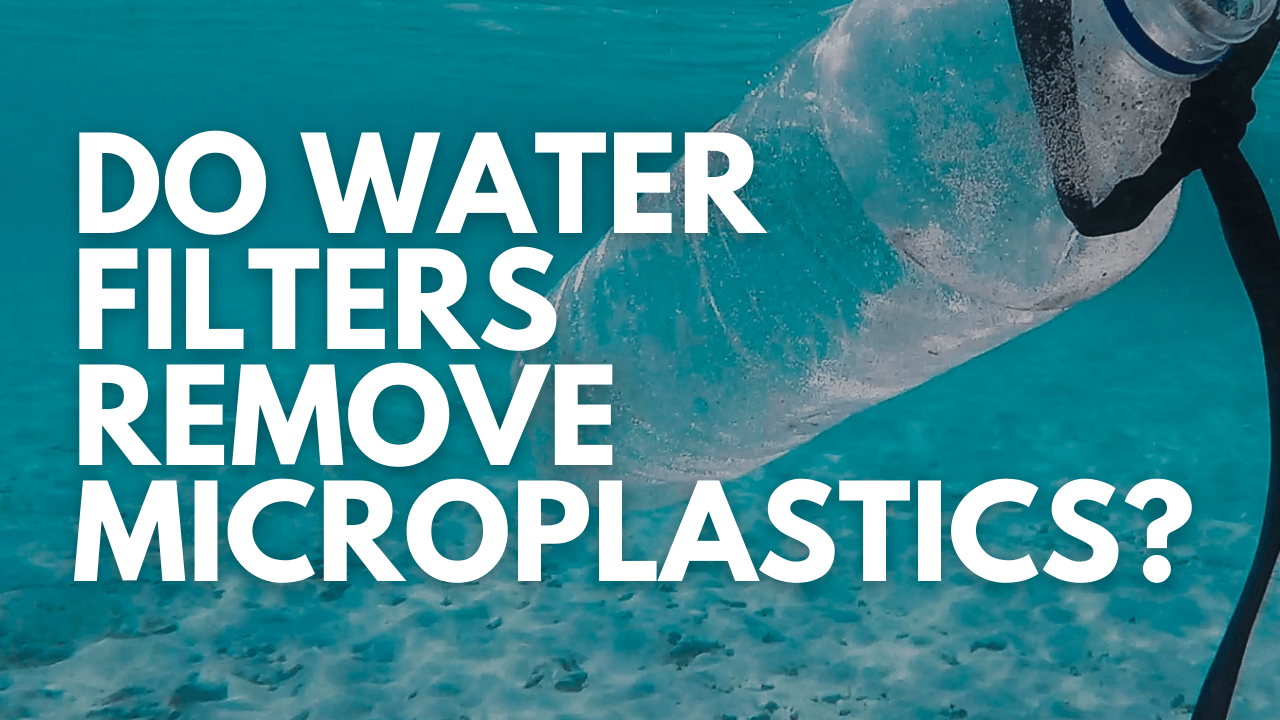Let's talk about something that's got a lot of people worried these days: microplastics in our water. You've probably heard the news – these tiny bits of plastic are everywhere, and it's only natural to wonder if your water filter at home is doing its job against them. The good news is that some filters can indeed remove these contaminants out of your drinking water, or at least cut their numbers down significantly.
In this article, we will look at how these microplastics might be affecting our health, which types of water filters are the top choices at removing them and what we can all do to look after ourselves and the environment a bit better.
Table of Contents
So, What Exactly Are Microplastics?
Basically, microplastics are tiny specks of plastic that are smaller than 5 millimetres across. They come from all sorts of places, like old plastic trash breaking down, tiny fibres that shed off our synthetic clothes when we wash them and even as by-products from some industries.
These microplastics are now turning up in our oceans, lakes, the soil and even in the air we breathe. The real concern is that they don't biodegrade, so they can stay in the environment for a long time, maybe even thousands of years – building up in ecosystems and even the food chain.

Microplastics is a “Pandemic” of Its Own Kind!
It's a bit grim, but studies have found microplastics in both our tap and bottled water. Research suggests that a fair number of drinking water samples actually contain these microplastics. Marine life often mistake these plastics for food, and then they build up in their systems. So, if you're a fan of seafood, there's a decent chance you're also consuming microplastics indirectly.
And it's not just the water – microplastics are also found in the dust around our homes, in the air and even in some processed foods. It really is a growing problem, and it makes you think seriously about filtering them out of our drinking water.

This chart from Statista, based on a 2018 study by Orb Media, paints a picture of the reality of microplastics. They looked at a number of bottled water brands from nine different countries and found microplastic contamination was pretty widespread, with an average of 325 particles in every litre.
How Do Microplastics Affect Our Bodies?
Once these microplastics get inside us, they don't just pass straight through, unfortunately. They can build up over time and potentially cause a few health problems.
Researchers have raised a few concerns linked to microplastics:
- Hormone Troubles: Lots of microplastics have chemicals in them like BPA and phthalates, which can mess with hormones – they're known as endocrine disruptors.
- Stomach Issues: Some studies suggest microplastics might play a part in things like inflammatory bowel disease (IBD) and other gut problems.
- Immune System Problems: Microplastics could weaken our immune system by causing inflammation and oxidative stress in the body.
- Organ Damage: More recent research suggests that the really tiny microplastics, called nanoplastics, can get into our bloodstream and build up in organs like the liver, kidneys and even the brain.
Prevention is always better than cure, so one of the smartest moves is to make sure your drinking water is as free from these contaminants as possible.
So, back to the main question: do water filters remove microplastics? Let's find out.
Do Water Filters Remove Microplastics?
Yes, water filters can remove microplastics, but not all filters are equally effective. The key factor is the pore size of the filtration system.
Based on research conducted by Orb Media, microplastics can be as small as 2.5 microns. So the best way to remove them is by a filtration medium as small or smaller than 2.5 microns. The finer the cartridge or membrane, the more plastics it will remove.
If you wish to use a water filter to remove microplastics from your drinking water, check out our collection of benchtop or undersink water filters to REDUCE microplastics, and reverse osmosis filters to REMOVE microplastics.
Contact us anytime if you have any questions, and we’d be happy to help.
Types of Water Filters and Their Effectiveness
1. Carbon Filters
Carbon water filters, like the activated carbon ones and carbon block filters, are pretty common nowadays. They can help cut down the number of microplastics in your water, but they might not get rid of them all. Granular activated carbon (GAC) filters usually have carbon particle sizes that are about 0.8 to 1.0 mm in size, which is a bit too big to trap the smallest microplastics. Denser carbon block filters, though, can catch smaller particles, so they're a better choice.
2. Reverse Osmosis (RO) Filters
Reverse osmosis filters are the best and most effective option for getting rid of microplastics from water. These systems use a special semi-permeable membrane with incredibly tiny pores – about 0.0001 microns. That's small enough to stop even the tiniest microplastics, plus other contaminants like heavy metals, bacteria and chemicals.
3. Ceramic Filters
Ceramic filters with a pore size smaller than 2.5 microns can also do a decent job of removing microplastics from your water. How well they work really depends on how dense the filter is and its structure. Some top-notch ceramic filters that are combined with activated carbon can reduce microplastics and give you better quality water overall.
4. Ultrafiltration (UF) Systems
These systems use membranes with pores that are between 0.01 and 0.1 microns. While they're definitely better than your standard carbon filters, they don't quite match up to reverse osmosis when it comes to completely filtering microplastics.

Best Water Filters to Remove Microplastics
If you're looking for the best water filters to remove microplastics, here are our top picks available right here at My Water Filter:
- Best if you're trying to save money: A Benchtop Gravity Filter with a Doulton British Berkefeld Candle.
- Best for most homes: An Ultrapure Benchtop or Undersink Water Filter.
- Most effective overall: An HPF 7 Stage Reverse Osmosis Water Filter.
A reverse osmosis filter is the best option to ensure the thorough removal of microplastics. It's brilliant at filtering out even the smallest particles from your water.
Other Ways to Cut Down on Microplastic Exposure
Using a water filter to remove microplastics is a good start, but cutting down on plastic use and pollution in general is just as important. Here are a few things we can all do:
- Say no to single-use plastics: Try to avoid using plastic bottles, straws and disposable utensils.
- Use a fibre filter in your washing machine: This can help catch synthetic fibres from your clothes before they head down the drain and into the water system.
- Get rid of plastic properly: Always recycle what you can, and never throw your trash where it doesn't belong.
- Go for natural fabrics: Clothes made from synthetics shed microplastics when they're washed. If you can, choose cotton, wool or other natural fibres.
- Wash synthetic clothes a bit less: Just washing your synthetic clothes less often can actually cut down on microplastic pollution.

A Healthy Ocean is Essential for All of Us
The concern about microplastics isn't just about our health – it's about looking after our planet. Scientists warn that if plastic pollution keeps going at the rate it is now, there could be more plastic than fish in the ocean in 25 years. That's a sobering thought. The best way to fight this is by all of us doing our part, both individually and together.
By investing in a good quality water filter to remove microplastics, cutting back on single-use plastics and making more sustainable choices in our day-to-day lives, we can all help to make our planet healthier and our drinking water cleaner.
Microplastics in Drinking Water – Tiny plastic particles (less than 5mm) are widespread in water, air and soil, and can cause risks to human health and the environment.
Effective Water Filters – Reverse osmosis (RO) filters are the best at removing microplastics, followed by ultrafiltration (UF) and ceramic filters. Dense carbon block filters also help but are less effective than RO.
Reducing Exposure – Using quality water filters, avoiding single-use plastics, installing fibre filters in washing machines and choosing natural fabrics can help minimise microplastic contamination.
Can Microplastics Harm Human Health?
Yes. Studies suggest that microplastics can disrupt hormones, cause digestive and immune system issues, and potentially accumulate in organs like the liver, kidneys, and brain.
Do All Water Filters Remove Microplastics?
No. Only filters with small enough pore sizes (below 2.5 microns) can effectively remove microplastics.
What is the Best Water Filter for Removing Microplastics?
The HPF 7 Stage Reverse Osmosis Water Filter is the most effective option for complete microplastic removal.










